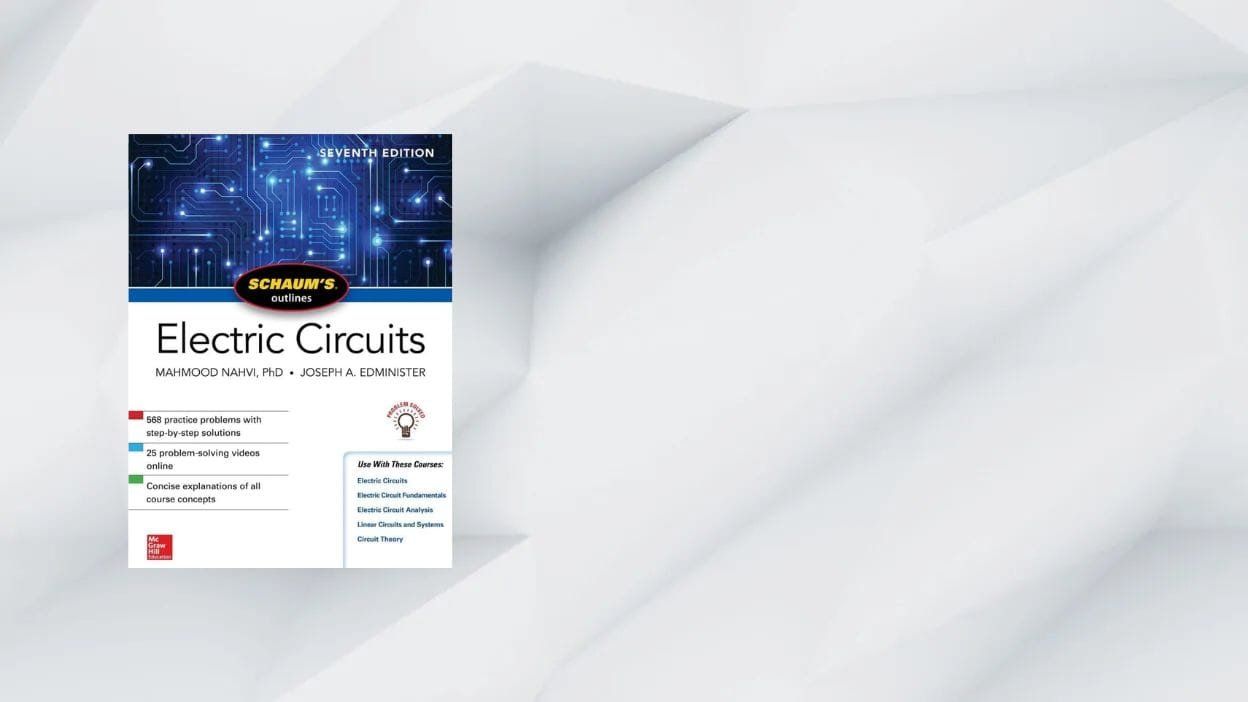If you studied electrical or computer engineering any time in the past 20 years, Electric Circuits 7th Edition by James W. Nilsson and Susan A. Riedel probably powered your problem sets. First published by Prentice Hall in 2004, this nearly-1000-page text remains a global staple for circuit-analysis fundamentals—even as the series has marched on to a 12th edition. Should you still reach for the seventh? Let’s dive in.
Book at a Glance
| Title | Electric Circuits (7th Edition) |
| Authors | James W. Nilsson & Susan A. Riedel |
| Publisher / Year | Prentice Hall • 2004 |
| Pages | 992 pp. |
| ISBN-13 | 978-0131465923 |
| Typical Used Price | US $15–40 (Amazon/eBay) |
| Goodreads Rating | 3.7 / 5 (250+ votes) |
| Target Readers | 1st–3rd-year EE/CE students, GATE/EIT exam takers, self-taught makers |
Why Electric Circuits 7th Edition Still Matters
- Concept-first pedagogy – Each chapter opens with an everyday “Practical Perspective” (e.g., guitar amplifiers, pacemakers) that links theory to real hardware.
- Balanced problem set – 75 % of the end-of-chapter problems were new or revised for this edition, ranging from plug-and-chug to design-oriented.
- Early SPICE exposure – PSpice and Multisim examples appear throughout, easing the leap from hand analysis to simulation.
- Bridges math levels – Integrates phasors, Laplace, and FFT ideas gradually, ideal for students coming from calculus II.
Chapter Highlights
| Ch. | Key Topics | Why It Helps |
|---|---|---|
| 1–3 | Circuit variables, basic laws, simple resistive networks | Ohm/KCL/KVL foundation with clear visuals |
| 4 | Methods of analysis (nodal, mesh) | Step-by-step examples with SPICE checks |
| 5 | Operational amplifiers | Ideal-op-amp shortcuts + non-ideal caveats |
| 6–7 | Capacitance, inductance & first-order transients | Time-domain intuition + real-world lab tips |
| 9 | AC steady-state analysis | Phasor diagrams before heavy math |
| 10 | Power calculations | Instant link to energy-efficiency labs |
| 12–13 | Laplace transform & frequency response | Gentle ramp toward control-systems coursework |
| 15 | Two-port networks & filters | Design-ready tables for Butterworth/chebyshev filters |
Strengths
- Student-friendly visuals – The seventh edition introduced a four-colour art program that clarifies sign convention and current direction.
- Robust ancillary kit – Instructor PowerPoints, PSpice files, and self-assessment quizzes (often still circulating on campus servers).
- Realistic numerical values – Problems use standard-value resistors and realistic op-amp specs, making breadboarding easier.
Limitations
| Issue | Impact | Quick Fix |
|---|---|---|
| No coverage of op-amp slew-rate, CMOS logic, or Arduino-era I/O | Modern lab contexts missing | Pair with Horowitz & Hill or newer Nilsson 12e chapters |
| SPICE screenshots reference an old DOS interface | Minor UI mismatch for today’s LTspice/Multisim | Replicate circuits; results still match |
| Imperial units sprinkled in power chapters | Potential confusion outside US | Stick to SI in your own notes |
How It Compares
| Feature | Electric Circuits 7e | Fundamentals of Electric Circuits 7e (Alexander & Sadiku 2020) | Introduction to Electric Circuits 7e (Dorf & Svoboda 2006) |
|---|---|---|---|
| Pages | 992 | 1 456 | 864 |
| SPICE integration | PSpice/Multisim | Multisim + MATLAB | PSpice only |
| Practical vignettes | Yes (“Practical Perspective”) | Occasional sidebars | Minimal |
| Math rigour | Medium | High (diff-eq heavy) | Medium |
| Best for | Balanced theory & design | Deep analytical skills | Quick intro courses |
FAQ
Is Electric Circuits 7th Edition good for beginners?
Yes—the pacing assumes only pre-calculus algebra at the outset, building up gradually to Laplace transforms.
Does it include solutions?
Only odd-numbered answers in the back. A full solutions manual exists for instructors; unofficial PDFs float around online.
How different is the 7th from later editions?
Core theory is unchanged. Newer editions add MOSFET intro, enhanced design examples, and updated SPICE screenshots—but page-for-page the 7th remains 90 % relevant.
Where can I buy it?
Used hardcovers list on eBay and Amazon from about US $15. International paperback versions are also common.

